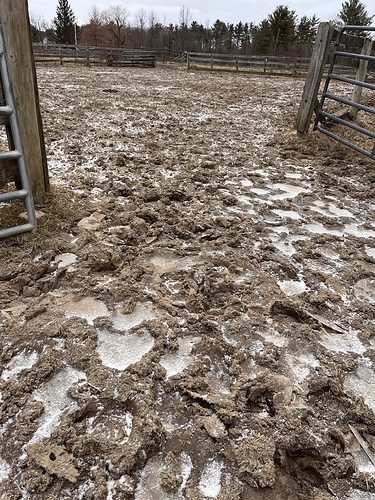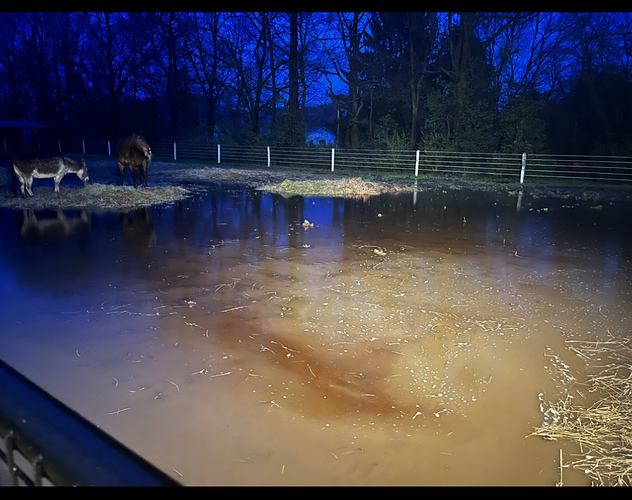This is like the best thing I’ve read in a while  Luckily I have a skid steer and the very small amount of this kind of work I’ve done, I was able to make a pretty level pad outside some of my run in sheds. I’d even consider bringing in a vibe roller to make sure it’s super level and super packed. My issue is mostly snow melt that leaves shin-deep puddles in some places. I’m excited to do some dirt work this summer!
Luckily I have a skid steer and the very small amount of this kind of work I’ve done, I was able to make a pretty level pad outside some of my run in sheds. I’d even consider bringing in a vibe roller to make sure it’s super level and super packed. My issue is mostly snow melt that leaves shin-deep puddles in some places. I’m excited to do some dirt work this summer!
Lol love this thread. Came here after the “Dream Farm” post on Off Course. I’m in NY with heavy clay. I have dry lot areas but after 15 years of use they need regrading so maybe this summer. Still better than pastures and gate areas….which are either 10” deep boot sucking mud, or a rice paddy right now.
I think we should post mud photos just to make the OP feel better. 
@susanne I just ordered these from AgTec since they have free shipping on a pallet. After talking to them I’ve learned they’ll probably work for some of my areas of mud but they recommend putting down fabric underneath them versus their heavier-duty (and twice as expensive  ) grids.
) grids.
Which one did you get?
Yeah we did this twice and ended up literally burying hundreds of dollars worth of gravel, LOL. Lesson learned.
But I think you’re right…just gotta wait it out and have a plan for next year. Deep breaths
Oooooo asphalt millings…I’ve never heard of this! I think most folks around here use limestone screening/limestone dust. Have you tried both? Wonder if one is better than the other…
PLEASE DO!! MISERY LOVES COMPANY! 


I don’t live in an arid climate. In fact annual precipitation is quite high in the national averages scale. That said, I live on a coastal plain and my ground is a sandy clay mix and my property has a nice sloping grade N to SE. I might get an inch or two of smushy mud in high traffic areas. Less this year after taking the box blade to my sacrifice lot last summer. I don’t loose rock or sand footing. We just dump and spread.
Great to hear. The cost of some people’s small dry lots makes me want to vomit. While I’m not working with several acres, I do have pretty large areas in several lots that need help. So when I start calculating based on square footage, it sounds impossible due to fabric and grids and large aggregate and medium aggregate and stone dust, etc etc etc.
I hear you. I read about people building arenas and the price is insane just for the sub base and base. I mostly ride in my sacrifice paddock over winter to save the rye grass in the grazing paddocks and it does fine. Recently we had over an inch of rain one day and the sacrifice paddock was completely rideable the next day. Less the hole my horse digs to sleep in 
I’m tempted to do the same thing for an arena. Just level (with a slope) and compact an area, throw down some road base and compact, then sand on top. I may regret it, but it also just might work out. And if I have something better than lumpy pasture to ride in, I’ll be the happiest person on earth.
What’s interesting to me, and slightly on topic for this thread, is the nomenclature of “material” and how it can differ by region. For example, limestone screenings in my area are fairly large pieces with some fines that resemble angular gravel. It packs up good but isn’t at all suitable for horse turnout areas or an arena. The large pieces will work to the top. In other areas, limestone screenings are a very fine (size wise) product it seems and possibly interchangeable with stone dust. In my area, stone dust is basically an unheard of term, but if I say “fines” folks know what I’m talking about (but like hard to get in my area). If I asked for road base, I might get crushed concrete, asphalt millings or limestone screenings.
Most built arenas here are some combination of clay and sand. There are three arenas in my immediate neighborhood. One is simply native dirt that’s worked occasionally (the top soil was left in place so it does grow grass if it isn’t worked regularly). Another has a layer of sand on top of native dirt (top soil scraped off first). The third is in a lower spot and was built up w sandy red clay than more sand on top. A popular product for footing here is a sand / clay mix that’s approximately 70/30. Supposedly the clay content helps it from being too dusty.  I know of exactly one local arena that had any kind of rock base installed and the owner hates it bc the rocks work their way up.
I know of exactly one local arena that had any kind of rock base installed and the owner hates it bc the rocks work their way up.
We have dropped to below freezing temps but the ground is still a bit soft. I’ll take it. This gate area is a small stretch of native clay and leading into an 80x100 arena (which is what you’re looking at) that is normally pretty dry compared to the local clay. It lately has been more like quicksand with no place for the water to drain. I can live with spring mud because it’s much more temporary. Fall and winter mud is defeating. Perfect word. Getting a wheelbarrow or wagon through this is impossible. 
To make everyone feel better about their mud…
Last spring we had a very heavy night of rain. I was horrified to walk out to this in the morning:
Horses were no worse for it.
That section of that particular paddock stays muddy all winter. Thankfully drainage is better in my other fields. It also dries up fine in the summer. One day when I win the lottery I will liberally apply enough money to fix it.
That is going to take loads of fill to take care of. 
It doesn’t look like that the most of the time. 
We had several inches of rain fall over a few hours.
That paddock is long and skinny and the section near the gate is slightly lower than the rest of the field, so everything drains that way. But yeah, it’s going to be an undertaking to raise it up.
I’m sure it doesn’t! Just like many paddocks don’t look like total mud holes except for maybe a month per year depending on where you live, and any particular year depending on the area you live in.
Omg, I imagine it would be quite unsettling to wake up and find your horse/donkey on an island!
For a drainage issue like that, I wonder if it would help to build the low spots up with compacted fill dirt, grade it to an appropriate slope, add topsoil, seed it, and give it time to settle and grow grass? Fill dirt should be cheaper than French drains or the necessary amount of stone, geocloth, etc. Has anyone tried building up low-lying areas this way?
We need to redo the drainage trench to the pond: there is one, but it’s filled in with vegetation over the years so that it’s no longer as effective to drain that part of the property.
That was the first night home from the hospital for my surprise foal and her dam, as if that period was stressful enough! 
And cliffs notes for anyone who cares: we have been on this farm a little over a year. We bought it with the existing infrastructure (well, what the sellers couldn’t steal over the 9 month delay to closing, they stole most of the outbuildings). It was never turnkey, but between inspection and closing it became a much bigger project than it started off as.
These are the ones we got: https://www.agtec.com/agtec-ultra-strong-mud-control-grids-pallet-
We got the heavy duty individual mats that look like the Hahn grids:
They are expensive, but they don’t need anything laid down beneath them. Even putting just a few down in an especially swampy area, they make a solid pad that doesn’t sink into the mud.


